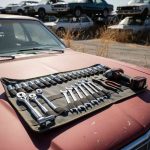Understanding the Importance of Factory Date Codes
When it comes to achieving an authentic, period-correct vehicle restoration, verifying the manufacturing date codes stamped on Original Equipment Manufacturer (OEM) parts is absolutely crucial. These mysterious markings aren’t just random numbers and letters – they’re the DNA of automotive authenticity, linking specific parts to your vehicle’s production timeline and indicating the manufacturing plant, year, month, and sometimes even the day or shift when the part was made.
For restorers and meticulous DIYers, understanding these codes can mean the difference between a good restoration and a show-winning masterpiece. Whether you’re sourcing parts from junkyards near me or evaluating components already on your project vehicle, knowing how to read factory date codes ensures every part belongs to the correct era.
General Principles of Factory Date Code Systems
Before diving into manufacturer-specific systems, it’s essential to understand the fundamental principles that govern factory date codes across the automotive industry:
- Purpose: Date codes verify that parts were manufactured reasonably near or prior to the vehicle’s assembly date
- Variability: Systems varied significantly between manufacturers and changed over different eras
- Location: Codes can be etched, stamped (ink or steel punch), or cast directly into the part
- Supplier Variation: Multiple suppliers means different markings even for identical part numbers
- Timing: Smaller parts were typically manufactured 1-2 weeks before final vehicle assembly
The key to successful restoration lies in documenting your specific vehicle’s original markings before removal. This documentation becomes your authentication reference when sourcing replacement parts.
Ford Motor Company Date Code Systems
Ford utilized several sophisticated formats for date codes, often combining date stamps with separate engineering or casting number prefixes. Understanding these systems is essential for finding authentic Ford parts during restoration projects.
Ford Casting Date Format
The most common Ford casting date format uses a four-digit code system. For example, “6M08” on an engine block breaks down as follows:
| Position | Example | Meaning |
|---|---|---|
| First Digit | 6 | Year of decade (1976, 1966, 1956, etc.) |
| Second Character | M | Month (December in this case) |
| Last Two Digits | 08 | Day of the month (8th) |
Ford’s month coding system skips certain letters to avoid confusion:
- A/N = January
- B/P = February
- C/Q = March
- D/R = April
- E/S = May
- F/T = June
- G/U = July
- H/V = August
- J/W = September
- K/X = October
- L/Y = November
- M/Z = December
Ford Engineering Number Prefixes
Ford’s engineering part numbers contain embedded date information. In the part number C5ZZ-6881-A:
- C = 1960s decade (A=40s, B=50s, C=60s, D=70s, E=80s, F=90s)
- 5 = 1965 specific year
- Z = Model line (often Mustang for 1964-73)
Ford Glass Date Codes
Glass suppliers like LOF (Libbey-Owens-Ford) and Carlite used their own coding systems. A simple “6B” marking typically means February of 1966. More complex systems used letter combinations after “LAMINATED” with month codes like N=January, X=February, L=March, paired with year letters in cycles.
General Motors Date Code Interpretation
GM’s approach to date coding was highly part-specific and plant-dependent, making it one of the more challenging systems to decode. Different engine plants like Flint and Tonawanda had their own conventions, as did body and trim manufacturers.
GM Engine Block Castings
Engine block date codes varied by manufacturing location:
- Flint Engines: Letter for month, one or two numbers for day, single digit for year
- Tonawanda Engines: Similar format but used two numbers for the year (e.g., “67” for 1967)
- Date Stamp Pad: Four-number format where “0221” = February 21st
GM Trim Tags and Body Dates
GM trim tags followed production model years with specific formatting. A date code like “B16” on a 1965 production body indicates assembly on September 16th, where ‘B’ represents September in their coding system.
For 1963 vehicles specifically, GM used a unique system with a letter for the month and numbers 1-6 representing the week within that month.
GM Carburetor Date Codes (Holley)
Holley carburetors used on GM vehicles had evolving date code systems:
| Period | Format | Example | Decoding |
|---|---|---|---|
| Early | Three digits | 782 | 1967, August, 2nd week |
| Later | Four digits | 0131 | 13th day of 1971 |
Mopar (Chrysler/Dodge/Plymouth) Dating Systems
Mopar’s date coding systems had their own unique characteristics, with the production year typically running from August 1st to July 31st rather than following the calendar year. This is crucial when sourcing authentic Mopar parts for restoration projects.
Mopar General Dating Types
Mopar utilized several distinct coding formats across different part types:
| Type | Format | Example | Typical Parts |
|---|---|---|---|
| Type A | Month & Year | E9 = May 1969 | Carburetors, fuel pumps, driveshafts |
| Type C2 | Calendar Year | 70 = 1970 | Alternators, starters |
| Type D2/D3 | Month, Day & Year | 12 6 71 = Dec 6, 1971 | Alternators, engine blocks |
| Type D1 | Production Week & Year | 301 = 30th week 1971 | Exhaust manifolds, coils, horns |
Mopar Glass Dating
Mopar glass used a distinctive dot system within boxes to indicate manufacturing dates. The number of dots within spokes or boxes corresponds to the month – for example, 5 dots = May, 10 dots = October. This visual system was unique to Chrysler’s suppliers and remains one of the more straightforward dating methods once understood.
Common Part Location Guide for Date Codes
Finding date codes requires knowing where to look on different automotive parts. Here’s where you’ll typically find these crucial markings:
- Engine Blocks: Cast into the block near the oil filter or on the deck surface
- Intake/Exhaust Manifolds: Usually on the underside or rear face
- Glass: Lower corners, often requiring a flashlight to see clearly
- Alternators/Starters: On the housing, sometimes under mounting brackets
- Transmissions: On the case, typically on the passenger side
- Carburetors: On the main body, often near the fuel inlet
- Radiators: On the tank or core support brackets
When searching for parts at salvage yards, understanding these locations helps you quickly verify authenticity and dating before removal.
Essential Tools and Documentation for Code Reading
Successfully reading and interpreting factory date codes requires the right approach and tools. Here’s what every serious restorer should have:
- Good lighting: LED flashlights or headlamps for dark areas
- Wire brushes: To clean decades of grime from cast markings
- Magnifying glass: For reading small or worn stampings
- Digital camera: Document every code before and after cleaning
- Reference materials: Manufacturer-specific decoding guides
- Notebook: Record codes systematically with part descriptions
“The key to authentic restoration isn’t just finding the right part – it’s finding the right part from the right time period. Date codes are your roadmap to authenticity.”
Advanced Dating Techniques and Cross-Referencing
Professional restorers often use multiple verification methods to ensure part authenticity. This involves cross-referencing various indicators beyond just the primary date code:
Supplier Code Correlation
Many parts have both manufacturer date codes and supplier identification marks. For example, a Delco alternator might have both GM’s internal dating system and Delco’s own supplier code. Understanding both systems provides additional verification layers.
Assembly Line Sequencing
Parts should show logical progression through the assembly process. Engine blocks typically predated final assembly by weeks or months, while smaller electrical parts might be dated just days before vehicle completion. This timing relationship helps validate authenticity when multiple date codes are present.
Common Date Code Reading Mistakes to Avoid
Even experienced restorers can misinterpret date codes. Here are the most frequent errors and how to avoid them:
- Decade confusion: A “6” could be 1956, 1966, or 1976 – context is crucial
- Month letter variations: Different manufacturers used different letter systems
- Supplier variations: Assuming all similar parts use identical dating systems
- Model year vs calendar year: Auto manufacturers often used different year cycles
- Regional differences: Canadian plants sometimes used different coding
- Restamp identification: Learning to spot fraudulent or altered codes
Digital Age Resources for Code Verification
Modern technology has revolutionized date code research and verification. Online databases, forums, and digital archives provide unprecedented access to manufacturer documentation and cross-reference materials.
Many enthusiast websites maintain extensive databases of date codes with photographic examples. The AERA automotive rebuilding association provides technical resources that can help with understanding manufacturing standards and dating conventions.
When combined with traditional reference materials and hands-on experience, these digital tools create a comprehensive approach to authentic part identification and verification.
Building Your Date Code Reference Library
Serious restorers should develop comprehensive reference libraries specific to their project vehicles. This includes:
- Original factory service manuals with part illustrations
- Manufacturer-specific restoration guides
- Supplier catalogs showing date code examples
- Photography documentation of original, untouched vehicles
- Digital archives of authentic parts with verified dates
- Network connections with other restorers and experts
Whether you’re working on a concours-level restoration or simply want to maintain period correctness, understanding factory date codes transforms part hunting from guesswork into precision authentication.
Essential Advice for Restoration Success
The foundation of successful date code authentication lies in thorough documentation and systematic approach:
- Document everything: Photograph all original part markings before removal with clear, high-resolution images
- Consult specific guides: Generic information isn’t enough – find resources specific to your exact model and year
- Understand supplier variations: The same part number could have different markings depending on the supplier
- Verify timing relationships: Ensure part dates make logical sense within the assembly timeline
- Build expert networks: Connect with other restorers working on similar vehicles
- Maintain detailed records: Create a database of what’s correct for your specific vehicle
If you’re ready to start sourcing authentic parts or need to sell a project vehicle for cash, understanding date codes gives you the knowledge to make informed decisions about authenticity and value.
Remember that achieving authenticity isn’t just about having the right part – it’s about having the right part from the right time period. Factory date codes provide that crucial link between your restoration and automotive history, ensuring your finished project represents not just how the car looks, but when it was truly built.
The journey of reading factory date codes transforms ordinary restoration into historical preservation, where every part tells a story and every number connects your vehicle to its original moment in automotive time.





Leave a Reply
You must be logged in to post a comment.